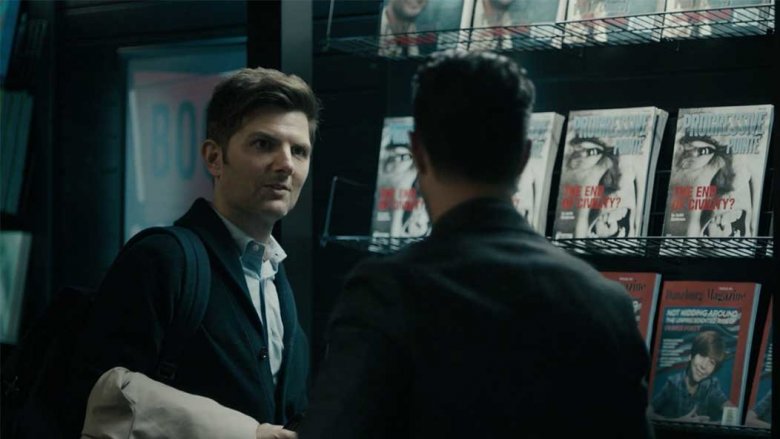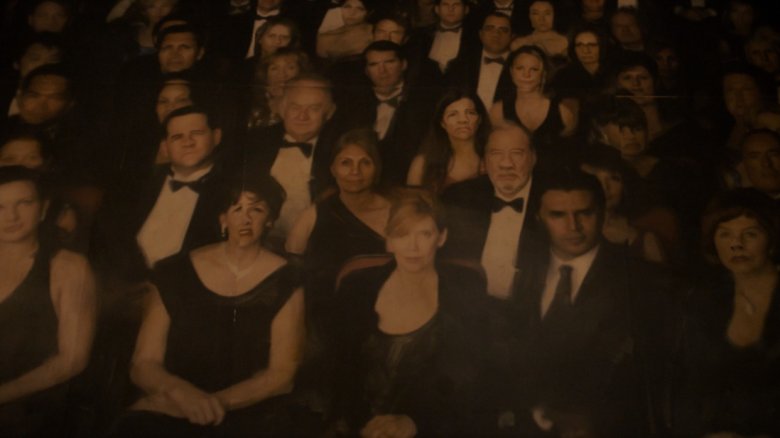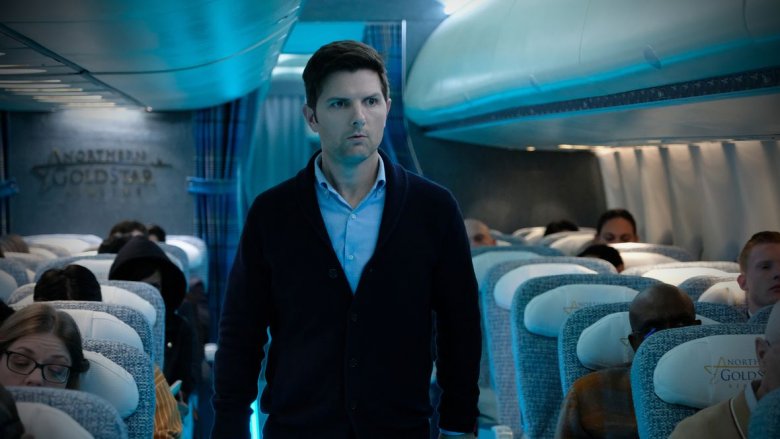Small Twilight Zone Details You Missed
You are about to enter another dimension. A dimension not only of clicks and streams, but of entertainment. A journey into a wondrous land of television both new and old. That's the login up ahead. Next stop: CBS All Access.
Yes, it's a new media landscape in which the latest iteration of The Twilight Zone has materialized. Though two TV reboots (one for three seasons in the '80s, another in 2002) and a movie (the tragedy-stricken 1983 endeavor) have come before it, nothing has ever fully recaptured the groundbreaking success of Rod Serling's original, which ran for five seasons on CBS between 1959 and 1964.
The new show certainly has a lot going for it, not the least of which is Jordan Peele — quickly becoming one of the most important creative voices of his generation — following in Serling's footsteps as host and executive producer. The defining question about any version of The Twilight Zone is how it uses mind-bending high concepts to reflect the sociopolitical issues of its time. Serling's stories usually had shockingly insightful and startlingly progressive hearts, beating beneath tales of lost souls, time warps, killer dolls, and sky gremlins.
The fact that this Zone is unlocked with the key of a streaming subscription says a lot about the challenges faced in exploring our own era. With on-demand entertainment, 24-hour news outlets, and the swirling eddies of social media, this decade would be unrecognizable to Rod Serling... or would it? As long as our miraculous technological advances are still playing host to fear, greed, and prejudice, we'll sadly still see ourselves reflected in The Twilight Zone.
While critics and audiences dissect the big ideas and dazzling images of each new episode, let's take a closer look for some Twilight Zone details you may have missed.
Dimension parallels
The Twilight Zone debuted with the first two episodes — "The Comedian" and "Nightmare at 30,000 Feet" — appearing on CBS All Access simultaneously (CBS also made "The Comedian" available to watch for free on YouTube). Among the most fascinating things that become clear watching the first two stories back-to-back (if you're watching closely, anyway) are the subtle connections between them. We have reason to believe that all of the individual stories this anthology series might be taking place in a shared universe.
Samir's (Kumail Nanjiani) rise to stand-up fame in "The Comedian" ends with his own total disappearance as he "gives himself" to the audience, bringing his own destructive powers to an end. But sharp-eyed viewers in a Twilight Zone marathon will see him again moments later — on a magazine cover at the airport newsstand at the beginning of "Nightmare at 30,000 Feet." Upon noticing this blink-and-you'll-miss-it bit of set dressing, revisiting Samir's airplane crash early in "The Comedian" suddenly feels like direct foreshadowing of the second episode.
On that note, is the "Mission to Mars" display seen prominently in "Nightmare" set to tie in with the upcoming space-set episode glimpsed in The Twilight Zone's trailer? We shall see.
Mirror image
"The Comedian" is bookended by shots of the back wall of Eddies ("no apostrophes allowed") Comedy Club. A massive mural depicts an audience taking in a classic show in the bygone days of the theater. While there's nothing particularly unsettling about the image the first time we see it (as Samir speaks the eerily appropriate opening line of the series, "Crazy times, guys, crazy times..."), when we revisit it at the end, we find that Samir himself has been absorbed into the two-dimensional crowd.
Beyond what this means for the plot of the episode, there are two references being made here. The first is an undeniable nod to the final shot of Stanley Kubrick's The Shining — iconic in the annals of horror cinema — in which an old photo reveals that Jack Torrance has "always been" at the Overlook Hotel. Peele is an avid fan of Kubrick's classic, going so far as to don low-key cosplay on the promotional tour for Us.
There's another element of the mural that's a little subtler, but more directly Twilight Zone-related. The seams of the wall are distorting some of the faces in the crowd, to the point that they bear a striking resemblance to characters from two different classic episodes: both "The Masks" (in which a greedy family have their faces twisted to reflect their inner ugliness) and "Eye of the Beholder" (in which a conventionally attractive woman is outcast from a society of pig-faced citizens).
People are alike all over
A lot of names flit through the screen during "The Comedian," as Samir discovers — first to his horror, then eventual delight — that inserting people he knows into his stand-up routine will cause them to vanish. We catch glimpses of his phone's contact menu and his social media friend lists as he confirms the disappearances and goes searching for the worst of the worst people from his past, sacrificing them for his career while also making the world a better place... he thinks.
It may come as no surprise that, as is often the case when a movie or show needs long lists of names, these shots are filled with Easter eggs. Samir is apparently acquainted with just about every memorably-named character from The Twilight Zone's original five seasons, including such unmistakable monikers as Mr. Cadwallader, Al Denton, and "Mouth" McGarry. A particularly notable classmate of Samir's is Paul Grinstead, a character from "Mirror Image," an episode with some parallels to Peele's own story for Us.
Prop comedy
The original Twilight Zone is populated with curious objects almost as unforgettable as the characters who encounter them, from a most unusual camera to Chucky's grandmother, the Talking Tina doll. It stands to reason that the revival would gather together a few of these talismans in an effort to conjure the spirit of Serling. "Nightmare at 30,000 Feet" features an obvious one (it was even showcased in the series' trailer) in a toy version of the monkey-like "gremlin" creature spotted on an airplane wing by William Shatner in the episode's classic namesake, "Nightmare at 20,000 Feet."
"The Comedian" also has a cameo from a classic prop, though this one's a little easier to miss than that something-on-the-wing. Situated unnervingly in the comedy club's dressing room is a ventriloquist dummy, and yes, it's the dummy from "The Dummy." The original puppet from this 1962 episode is now owned by magician David Copperfield, who loaned it to the production with one stipulation — he wanted a shout-out on the new show. That's how this premiere episode came to have not only an inanimate star of the original series, but Samir's line, "I wanted to be the next Chris Rock, not evil David Copperfield!"
The Appointed Destination
The 1963 Twilight Zone episode "Nightmare at 20,000 Feet" is one of the most famous episodes of the original series. Directed by Richard Donner and starring William Shatner as a paranoid airline passenger convinced he sees a creature on outside his plane window, this standout installment has been parodied in everything from The Simpsons to, yes, Key & Peele. It was even remade by Mad Max director George Miller for The Twilight Zone: The Movie, with John Lithgow in the lead. That's why no one was surprised when it was announced that one of the new series' first episodes would be titled "Nightmare at 30,000 Feet."
But this remake isn't just a matter of an extra 10,000 feet. The paranoid passenger here is journalist Justin Sanderson (Adam Scott), but there's no gremlin on the wing. Instead, Sanderson finds a strange MP3 player loaded with a documentary podcast about a mysterious doomed flight — his mysterious doomed flight. As he tries to follow along with the podcast's evidence in an attempt to prevent an inevitable disaster, he eventually realizes (too late) that by doing so, he has become the cause of the plane's disappearance.
Not only does this total reinvention bring the show fully into the present (the episode could just as well have been called "Can Black Mirror Do Thiiiiiiis?"), it might also be a clever meta commentary on the mission of this new Twilight Zone. Peele and company have set up their audience for a remake of the original show's most familiar episode and then delivered an entirely different nightmare about the dangers of thinking that you know what story you're in. In doing so, they have primed fans both new and old to expect surprising twists on familiar visions.





